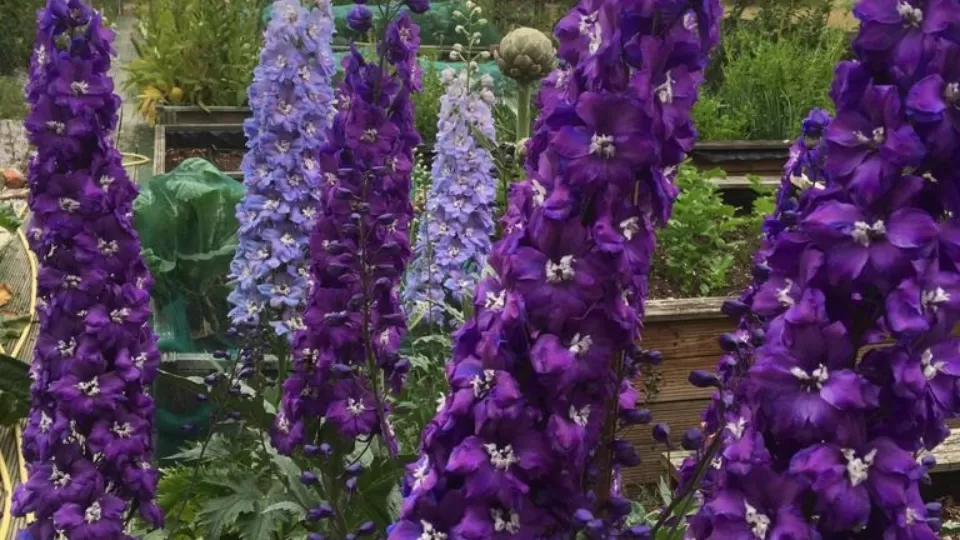RHS Chelsea Flower Show: How to create an ornamental border
With Chelsea Flower Show 2024 just around the corner, you may have decided you want to create your very own Chelsea-worthy flower border in your garden. With just a few clever planting choices and a simple structure to work with, designing your garden border can be a creative and enjoyable activity.
In this blog, find out some of the best plants for each area of your garden border, including tall ornamentals at the back, to the smallest ornamentals at the front, for a Chelsea-worthy border for you to enjoy.
Plants for the back of the border
The back of your border will require structural, towering plants, to make sure they are visible behind the plants in the middle and front. You have plenty of choices available, depending on your chosen style.
Ornamental grasses are a wonderful, neutral backdrop for striking garden borders. For example, Cortaderia selloana, or ‘Pampas grass,’ can reach up to 2.4 metres tall, and have silvery feather-like panicles on the ends, drawing the eye upward to take in the whole border. Or for an ornamental grass with a hint of colour, perhaps the Panicum virgatum, Switchgrass, with a hint of red along the end of each of the stems.
If you would prefer ornamental flowers at the back of your border, Delphiniums are classic choices you will see often at RHS flower shows. Coming in a range of colours, particularly cool blues and purples, they can reach up to 1.8 metres tall, towering over your garden borders in bright swathes.

Plants for the middle of the border
The task you need to consider with your middle-of-the-border plants is how to ensure they stand out and hold their own when surrounded by wonderful plants on all sides. You can do this by breaking up the border with different colours, alternative styles, and different shapes.
For a Chelsea staple which can come in a wide range of shapes and colours, Dahlias are the perfect choice for the middle of your border. Whether single flowered varieties such as the striped Dahlia ‘Twynings Candy’, or a pompom style like Dahlia ‘Dark Spirit,’ there is a Dahlia to suit your design.
Or perhaps for something more delicate and suited to cottage-style designs, the delicate flatted flowerheads of Verbena bonariensis provide subtle crackles of lavender colour through the middle of your border. This plant is a particularly good choice for pollinator-friendly garden designs.

Plants for the front of the border
The front of your border will feature the shortest plant varieties, whether that be ground cover or slightly taller ornamentals, depending on the heights of the rest of your border. Your front border plants also need to soften the edges and may need to be more shade-tolerant than your other plants.
Great for softening border edges, and notoriously easy to grow, Nasturtiums have bright and cheerful flowers, plus large, near-circular leaves which wonderfully fill in any groundcover gaps. For a softer colour, Nasturtium ‘Ladybird Rose’ is a lovely delicate mix of pinks and cream, or for a vibrant orange shade, Nasturtium ‘Orange Troika’ is lovely with variegated leaves for added interest.
If vibrant flowers are less of a priority for the front of your Chelsea border design and interesting foliage is a must, Heucheras have bold ornamental leaves in a range of shades. Plus, they each release tall spires of subtle flowers for additional summer interest. Whether it is moody purple shades such as Heuchera ‘Purple Petticoats,’ the eye-catching dark veining of the grey-green Heuchera ‘Venus’, or the warming gold of Heuchera ‘Caramel,’ there is a shade of this plant to suit the front of any border.
How to take care of your Chelsea ornamental border
One of the first plant-care steps you can take is regular watering of your borders. To take the worry of watering your border out of your hands, Irrigatia’s irrigation kits will do this automatically, maintaining a healthy and consistent moisture level which is perfect for your plants. Using the sun as a guide and power source, your garden will be in safe and sustainable hands.

Nutrients can help keep your ornamental border flowering consistently, which can be achieved with feeding. Spring and summer, during the growing season, is an ideal time to do this. One way to know if your plants need feeding is if they are producing fewer flowers than anticipated, so adding fertilisers such as homemade compost or liquid fertilisers can go a long way to help.
Just ensure to use 100% soluble fertilisers, otherwise use a ‘sand filter’, which will clean the water before application. You can do this easily at home, using a cleaned-out tall yoghurt pot.
Producing a border worthy of the Chelsea Flower Show and keeping it healthy is a wonderful creative outlet, which is easy given a simple structural system to work from. Try your hand at designing and planting your own using your favourite plants, styles, and colours this year.
Find the perfect automatic irrigation kit for your garden today at Irrigatia.



